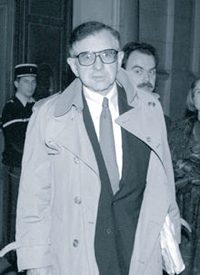
He was a prosperous abortionist and an influential force early in the movement to legalize abortion in America. But as Dr. Bernard Nathanson was brought face to face with the truth of what was happening when he helped women “terminate” their pregnancies, he had no choice but to abandon his “pro choice” platform and spend the rest of his days fighting for the unborn. On February 21, at the age of 84, Dr. Nathanson completed his life’s mission and met his creator. The cause of death was cancer, said his wife Christine.
Nathanson helped found the infamous National Abortion Rights Action League (now called NARAL Pro-Choice America) in 1969, and estimated he had performed some 75,000 abortions before he quit in 1979 after becoming increasingly uneasy about the possibility that he was, in fact, guilty of murder.
The New York Times reported that in a 1974 article in The New England Journal of Medicine, Nathanson “described his growing moral and medical qualms about abortion,” writing that he was “deeply troubled by my own increasing certainty that I had in fact presided over 60,000 deaths.”
That uncertainty became more pronounced as he began viewing unborn babies in mothers’ wombs through the emerging technology of ultrasound. “For the first time, we could really see the human fetus, measure it, observe it, watch it, and indeed bond with it and love it,” he recalled in his 1996 book The Hand of God: A Journey from Death to Life by the Abortion Doctor Who Changed His Mind. “I began to do that.”
Nonetheless, he continued performing the procedure, telling New York magazine in a 1987 interview, “On a gut, emotional level, I still favored abortion. It represented all the things we had fought for and won. It seemed eminently more civilized than the carnage that had gone on before.” But he added that it “was making less and less sense to me intellectually.”
In his pro-life conversion he was as passionate as he had been as a “pro-choice” activist, producing what would become a classic in defense of the unborn, the 1985 film Silent Scream, which includes heart-rending footage of a pre-born baby trying to escape the abortionist’s deadly tool.
“We see the child’s mouth open in a silent scream,” Nathanson can be heard narrating in the movie, as the slow-motion ultrasound records the struggling pre-born person. “This is the silent scream of a child threatened imminently with extinction.”
Abortion proponents charged that the movie was misleading, arguing that a 12-week-old fetus was incapable of feeling pain and that the “scream” was nothing more than an involuntary reaction to stimulus. To those opponents Nathanson responded, “If pro-choice advocates think that they’re going to see the fetus happily sliding down the suction tube waving and smiling as it goes by, they’re in for a truly paralyzing shock.”
In the video Nathanson goes on to accuse “Planned Parenthood and all its co-conspirators in the abortion industry of consistent conspiracy of silence, of keeping women in the dark with respect to the true nature of abortion.”
The Times reported that the film “won the enthusiastic praise of President Ronald Reagan, who showed it at the White House, and was widely distributed by anti-abortion groups like the National Right to Life Committee.”
The Times also noted that as a pro-life speaker, “Dr. Nathanson often drew gasps by painting himself, in his pro-abortion-rights days, in lurid colors. ‘I know every facet of abortion,” he wrote in his memoir, adding, ‘I helped nurture the creature in its infancy by feeding it great draughts of blood and money; I guided it through its adolescence as it grew fecklessly out of control.’”
But at his death pro-life leaders remembered him for his uncompromising commitment to reaching the nation and the world with the unvarnished truth about abortion. Jeanne Head of National Right to Life said that while Nathanson “was probably one of the individuals most responsible for Roe v. Wade … once he realized his error, he dedicated the rest of his life to reversing it.”
Father Frank Pavone of Priests for Life noted that his own life had intersected with Nathanson’s “since the mid-80s, and our last time together was just last week.” Pavone recalled that years back Nathanson had once told a group of priests, “I uncaged the abortion monster in the United States.” Pavone then said that the doctor told “us priests that he and his former colleagues ‘would never have gotten away with what we did if you had been united, purposeful and strong.’” According to Pavone, Nathanson’s rebuke became the core thrust of his organization’s pro-life efforts.
Joe Scheidler of the Pro-Life Action League recounted that at the time of Nathanson’s pro-life conversion back in the early 1980s, “I did not quite trust him. I was skeptical of his story that he didn’t realize abortion was the taking of a human life until he saw an ultrasound. Perhaps he just seemed too matter-of-fact about what he’d done, without the contrition that his role in the abortion business would warrant.”
But a chance meeting with the doctor in the lobby of an Indianapolis hotel where they were both staying would erase his doubts, Scheidler said. As they conversed, Scheidler expressed his misgivings about Nathanson’s sincerity. Recalled Scheidler of that meeting:
For some time he sat in total silence. And then he said, “Joe, do you realize what I have to face some day — 75,000 lives on my conscience? If I would admit outright the horror of what I was doing, I could not live with it. Someday I will face my judge with all those lives on my conscience. It’s almost too difficult to admit what I have done, so I have to approach my conversion in a way that will help me keep my sanity.”
I could see in his face that he was sincere — that his role as an abortionist and abortion promoter weighed on him more than he could express — and the only feeling I had for him was compassion. From that time on, we became good friends.
Reflecting on his friend’s life, Scheidler said, “Dr. Bernard Nathanson was a modern-day Saint Paul. Just as Paul had persecuted the early Church, only to become her greatest advocate, Nathanson turned away from the abortion movement he helped found to become one of the foremost champions of unborn children.”
Concluded Scheidler, “May his great soul now rest in peace.”



